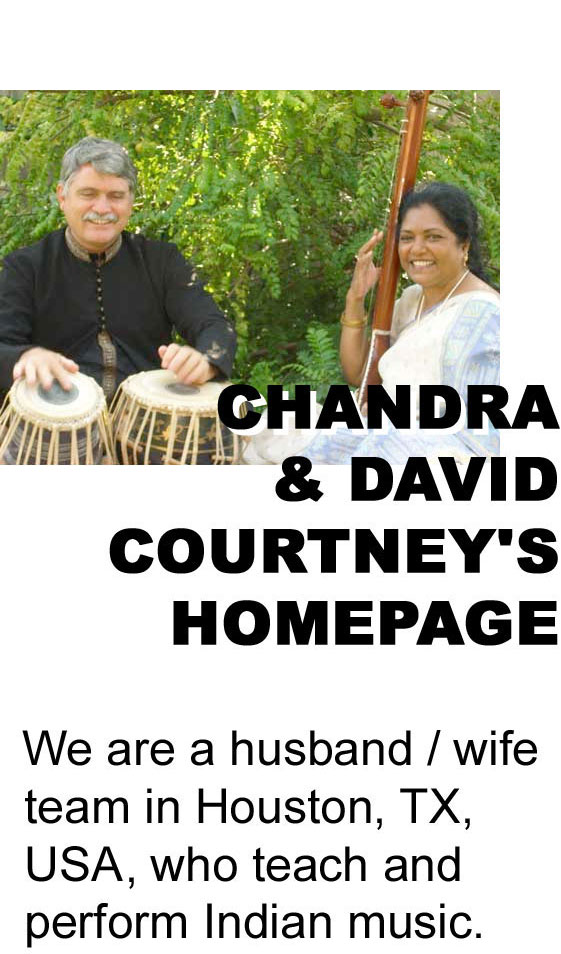ALTERNATIVE NAMES OF THE RAGS AND TALS
General Discussion
There is always confusion concerning the names of many of the rags. This confusion can result from different ways to transliterate the names; they may reflect different pronunciations within India; or they may be unrelated names that reflect different musical subtraditions.
Transliteration
Transliteration is the process of writing a word in a script other than the one it is normally written in. Transliteration is not to be confused with translation. If a word is translated from Hindi into English, an English equivalent is substituted for the original Hindi. In transliteration, the original Hindi word is used, but is written in Roman script.
Confusion often arises when transliterating the names of the rags because there is not an exact correlation between the Devnagri (ie., Hindi / Sanskrit) and the Roman script. Many times a Hindi / Urdu sound lies between two English letters. For instance there is a sound in Indian languages which lies between a "d" and an "r". Another example is that the Indian "w" is actually between an English "w" and a "v". Whenever one runs cross cases where "v"s replace "w"s or "d"s replace "r"s then this is the cause.
Transliteration is also confused by the fact that the Roman script is not treated in a consistent way across different European languages. For instance, before the turn of the 19th century, most Indian words were transliterated using an imprecise and archaic British approach. However, by the middle part of the 20th century there was a move to adopt a more consistent Germanic approach. This is one reason why many of the transliterations from the 18th and 19th century British travellers seems so awkward to us today.
Different Pronunciations Within India
India is a country with a large number of dialects, therefore pronunciations of terms vary. For instance, Vasant is unpronounceable to many people in the North-East part of India; people from these areas tend to call it Basant. In a similar manner, Urdu speakers have no trouble pronouncing Zila-Kafi, which becomes corrupted to Jila-Kafi by most Hindi speakers. Although there are some very easy and predicable ways that such sounds become altered, it is a topic that is more appropriate to studies of linguistics than that of music.
Different Subtraditions
India is a land with many musical subtraditions. Many times a rag will have completely unrelated names. For instance, Ahir Bhairav as often times known as Charavakam.
List of Common Alternate Forms
We are presenting below a list that cross references many of the common rags. This list should be considered a rough guide rather than a definitive reference. In some cases, there is disagreement as to whether two rags are actually the same. For instance there is disagreement as to whether todi and Mian-ki-Todi are actually the same rag. We will not get into such discussions here. We will only say that if a substantial number of people consider two rags to be equivalent, then we have tried to include it here. We must leave it to the individual reader to consider if there are any finer distinctions that need to be considered.
Rags
Bilawal - see also Shuddha Bilawal
Bhup - See also Bhupali Bhupali - See also Bhup
Darbari Kanada - see also Durbari Kanada
Darbarai Kanara - see also Durbari Kanada or Darbari Kanada
Durbari Kanada - see also darbari kanada or darbari Kanara
Eman - see also Yaman, Iman, Kalyan
Iman - see also Yaman, Kalyan, Eman Kalyan - see also Iman, Eman, Yaman
Mian-ki-Todi - see also Miyan-ki-Todi
Miyan-ki-Todi - see also Mian-ki-todi
Shuddha Bilawal - see also Bilawal
Todi - see also Thodi
Thodi - see also Todi
Tals
Rupak- see also pashtu
Punjabi Theka - see also Sitarkhani
© 1998 - 2021 David and Chandrakantha Courtney
For comments, corrections, and suggestions, kindly contact David Courtney at david@chandrakantha.com
